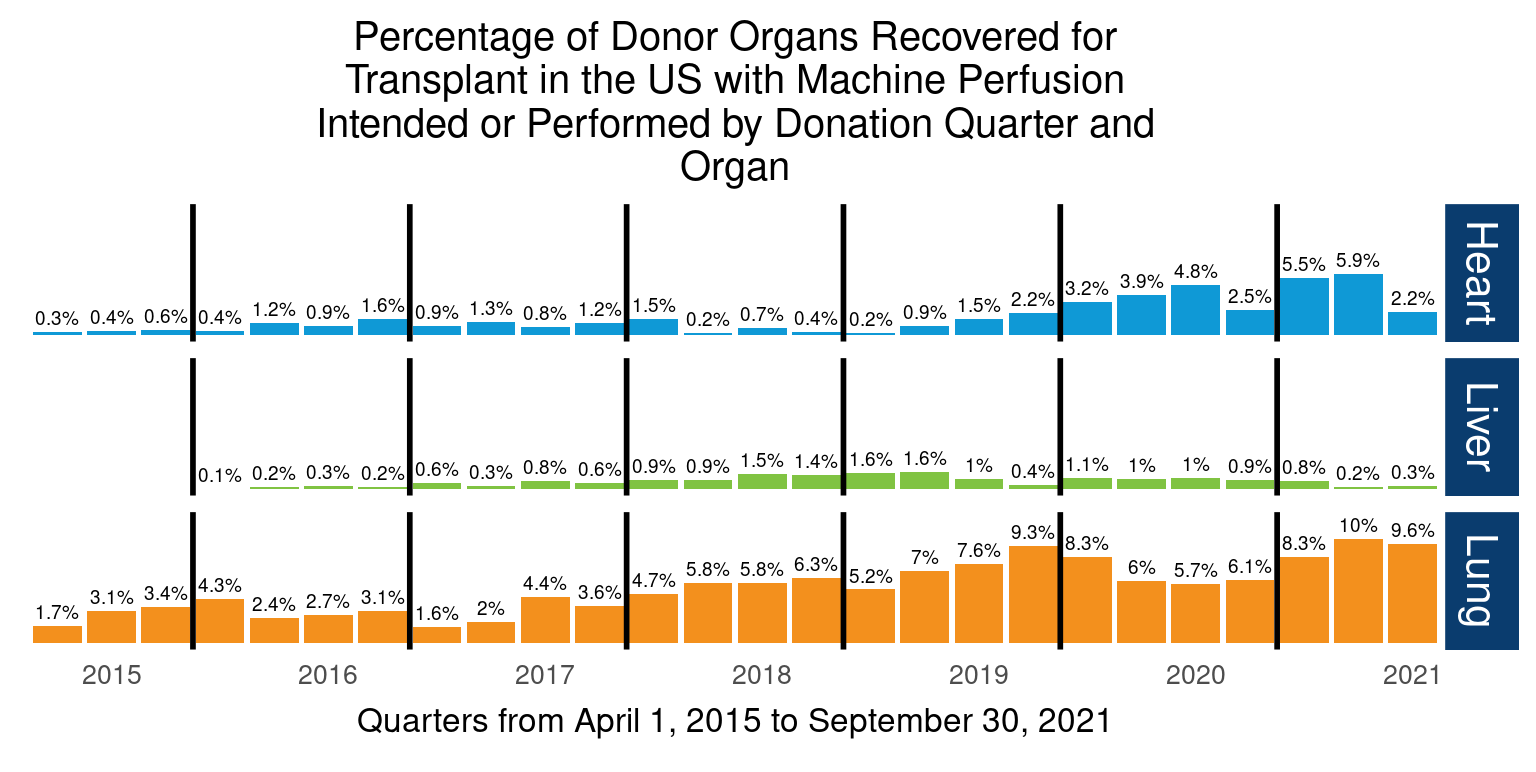Growing Use of Perfusion for Heart, Liver, and Lung and Early Outcomes
1United Network for Organ Sharing, Richmond, VA, 2University of Washington, Seattle, WA
Meeting: 2022 American Transplant Congress
Abstract number: 939
Keywords: Allocation, Donors, non-heart-beating, Perfusion solutions, Survival
Topic: Basic Science » Basic Science » 15 - Machine Perfusion and Organ Rehabililtation - Basic
Session Information
Session Name: Machine Perfusion and Organ Rehabilitation - Basic
Session Type: Poster Abstract
Date: Sunday, June 5, 2022
Session Time: 7:00pm-8:00pm
 Presentation Time: 7:00pm-8:00pm
Presentation Time: 7:00pm-8:00pm
Location: Hynes Halls C & D
*Purpose: In 2015 the OPTN began collecting data on perfusion for heart, liver, and lung deceased donors (DD) on the DD registration form. Since 2015, a number of perfusion devices have received FDA approval for heart (HR) and lung (LU) and more are currently in the clinical trial phase. The aim is to examine the prevalence of the use of perfusion in the US and outcomes for recipients of perfused organs.
*Methods: Using OPTN data, all DD with at least one LU, HR or liver (LI) recovered for transplant from 4/1/15- 9/30/21 were analyzed. The prevalence of perfusion was examined over time and by geographic area. Donor and recipient characteristics were compared for perfused and non-perfused organs. HR and LU 1-year unadjusted patient survival was compared for all perfused and all non-perfused organs from 4/1/15- 6/30/20 excluding pediatric recipients, repeat, and multiorgan transplants.
*Results: The use of perfusion has grown from almost non-existent to almost 10% of LUs, 6% of HRs and < 1% of LIs.
Since 4/1/15, 2,492 organs recovered for transplant have been perfused. A large percent of perfused organs recovered for transplant were from DCD DD (LU:33%, LI:21%, HR:48%). The ischemic time for perfused LUs and HRs was higher than that for non-perfused (LU: 10.4 vs. 5.4hrs; HR: 5.0 vs. 3.2 hrs). On average, perfused organs were from older donors for LU but not HR (LU: 39 vs. 35yrs; HR: 32 vs. 32yrs). Not accounting for differences in donor and recipient characteristics, one-year unadjusted patient survival is lower for recipients of perfused compared to recipients of non-perfused LUs (non-perfused=89.6% vs, perfused= 85.4% ,p < 0.01). There is not a significant difference in one-year unadjusted patient survival for recipients of a perfused compared to recipients of a non-perfused HR (non-perfused=92.0% vs, perfused= 91.7%, p=0.9).
*Conclusions: Since 2015, the use of lung and heart perfusion has been expanding. While an unadjusted survival analysis shows a difference for recipients of perfused lungs compared to non-perfused lungs, this analysis does not account for factors such as prolonged ischemic time, and donor and candidate characteristics that might impact patient survival. Additionally, the analysis does not recognize that this time encompasses when many devices were in clinical trials that were designed to utilize specific donor pools such as older and marginal donors. Importantly, early findings show the increased use of perfusion may contribute to expansion of the donor pool. Additional analysis is warranted to explore if survival differences exist after adjusting for donor and recipient factors.
To cite this abstract in AMA style:
Goff RR, Gauntt K, Cherikh W, Lease ED, Klassen D. Growing Use of Perfusion for Heart, Liver, and Lung and Early Outcomes [abstract]. Am J Transplant. 2022; 22 (suppl 3). https://atcmeetingabstracts.com/abstract/growing-use-of-perfusion-for-heart-liver-and-lung-and-early-outcomes/. Accessed December 11, 2025.« Back to 2022 American Transplant Congress

